
Starlings are small to medium-sized passerine birds in the family Sturnidae. The Sturnidae are named for the genus Sturnus, which in turn comes from the Latin word for starling, sturnus. Many Asian species, particularly the larger ones, are called mynas, and many African species are known as glossy starlings because of their iridescent plumage. Starlings are native to Europe, Asia, and Africa, as well as northern Australia and the islands of the tropical Pacific. Several European and Asian species have been introduced to these areas, as well as North America, Hawaii, and New Zealand, where they generally compete for habitats with native birds and are considered to be invasive species. The starling species familiar to most people in Europe and North America is the common starling, and throughout much of Asia and the Pacific, the common myna is indeed common.
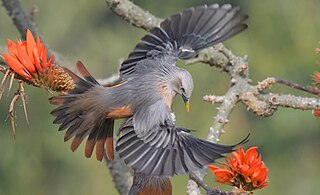
The chestnut-tailed starling, also called grey-headed starling and grey-headed myna is a member of the starling family. It is a resident or partially migratory species found in wooded habitats in India and Southeast Asia. The species name is after the distribution of a former subspecies in the Malabar region. While the chestnut-tailed starling is a winter visitor to peninsular India, the closely related resident breeding population with a white head is now treated as a full species, the Malabar starling.

The long-tailed glossy starling is a member of the starling family of birds. It is a resident breeder in tropical Africa from Senegal east to Sudan.

The superb starling is a member of the starling family of birds. It was formerly known as Spreo superbus. They are long-lived birds that can live over 15 years in captivity.
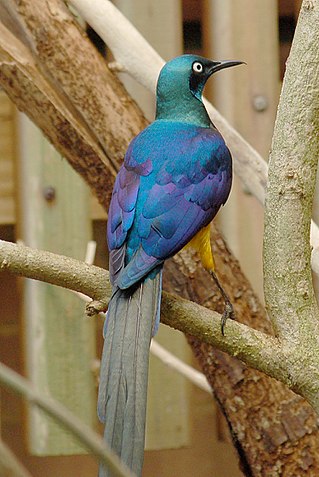
The golden-breasted starling, also known as royal starling, is a medium-sized passerine in the starling family.

Lamprotornis is a large genus of glossy-starlings all of which occur in Africa south of the Sahara. They have glossy blue or green upper parts, which is due to hollow melanin granules arranged in a single layer near the feather barbule's surface. This unique arrangement led to some glossy starlings formerly placed in the genus Spreo being transferred to Lamprotornis, since they shared this feature.

The red-winged starling is a bird of the starling family Sturnidae native to eastern Africa from Ethiopia to the Cape in South Africa. An omnivorous, generalist species, it prefers cliffs and mountainous areas for nesting, and has moved into cities and towns due to similarity to its original habitat.

The emerald starling is also known as the iris glossy starling. It is a small starling with a metallic green crown, upper body, wings and tail. The ear-coverts and underparts are metallic purple. Both sexes are similar. Most taxonomists unite it with many other glossy starlings in Lamprotornis, while others place it in a monotypic genus Coccycolius.
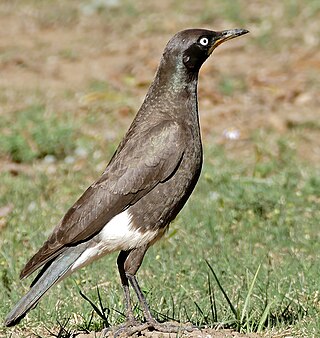
The pied starling or African pied starling is a bird endemic to South Africa, Lesotho and Eswatini. It is common in most of its range, but largely absent from the arid northwest and the eastern lowlands of South Africa. It is found in open habitats such as grassland, karoo scrub, thornbush and agricultural land, and often associates with farm animals.

Fischer's starling is a bird which is an uncommon resident breeder from southern Ethiopia and Somalia to eastern Kenya and Tanzania. It is found in dry open acacia thornbush.

The greater blue-eared starling or greater blue-eared glossy-starling is a bird that breeds from Senegal east to Ethiopia and south through eastern Africa to northeastern South Africa and Angola. It is a very common species of open woodland bird, and undertakes some seasonal migration.

Burchell's starling or Burchell's glossy-starling is a species of starling in the family Sturnidae. The monogamous and presumably sedentary species is native to dry and mesic woodlands and savannah of southern Africa. The name of this bird commemorates the English naturalist William John Burchell.

The bronze-tailed starling or bronze-tailed glossy-starling is a species of starling in the family Sturnidae. It is found in Benin, Burkina Faso, Cameroon, the Central African Republic, Chad, the Democratic Republic of the Congo, Gambia, Ghana, Guinea, Guinea-Bissau, Ivory Coast, Kenya, Mali, Niger, Nigeria, Senegal, South Sudan, Sudan, Togo, and Uganda.

The lesser blue-eared starling or lesser blue-eared glossy-starling is a species of starling in the family Sturnidae. It is found in Benin, Burkina Faso, Burundi, Cameroon, the Central African Republic, Chad, the Democratic Republic of the Congo, Eritrea, Ethiopia, Gambia, Ghana, Guinea, Guinea-Bissau, Ivory Coast, Kenya, Liberia, Malawi, Malaysia, Mali, Mozambique, Namibia, Nigeria, Senegal, Sierra Leone, South Sudan, Sudan, Tanzania, Togo, Uganda, Zambia, and Zimbabwe.

The Miombo blue-eared starling, also known as the southern blue-eared glossy-starling, is a species of starling in the family Sturnidae. It is found in Botswana, the Democratic Republic of the Congo, Kenya, Malawi, Mozambique, Namibia, Tanzania, Uganda, Zambia, and Zimbabwe.
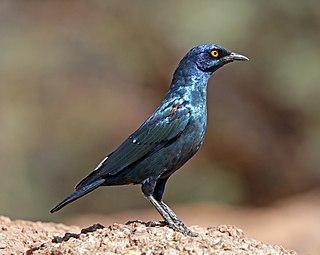
The Cape starling, also known as red-shouldered glossy-starling or Cape glossy starling, is a species of starling in the family Sturnidae. It is found in Southern Africa, where it lives in woodlands, bushveld and in suburbs.

The chestnut-bellied starling is a species of starling in the family Sturnidae. This is a common resident in arid Sahelian acacia savanna, namely in Burkina Faso, Cameroon, Chad, Eritrea, Ethiopia, Gambia, Ghana, Guinea, Guinea-Bissau, Ivory Coast, Mali, Mauritania, Niger, Nigeria, Senegal, Sudan, and Togo.

Rüppell's starling, also known as Rueppell's glossy-starling or Rueppell's long-tailed starling, is a species of starling in the family Sturnidae. It is found in Burundi, the Democratic Republic of the Congo, Eritrea, Ethiopia, Kenya, Rwanda, Somalia, South Sudan, Sudan, Chad, Tanzania, and Uganda.
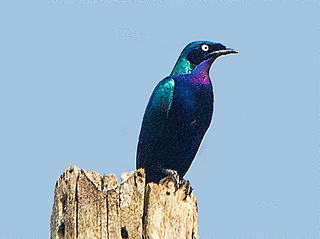
The splendid starling, also known as the splendid glossy-starling, is a species of starling in the family Sturnidae.
Johann Maria Hildebrandt was a German explorer, collector, and scientist.





















